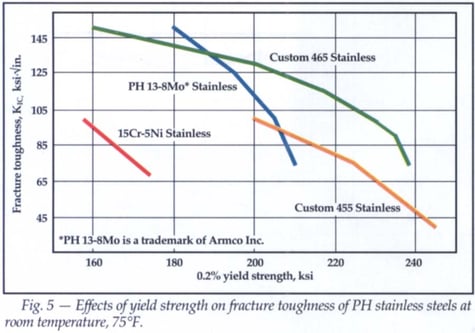Requirements for Ferrous-Base Aerospace Alloys
White Papers
Significant changes have occurred in the design criteria applied to the selection of alloys for civilian and military aircraft. They should come as no surprise because the old mantra that once characterized the aerospace industry - higher, faster and farther, without regard to cost - is history.
One is the demand for fewer defects, longer service life, and reduced maintenance and aircraft operating costs. Another is the desire for cheaper parts and components, all of which leads to lower life cycle cost. A third requirement focuses on the need for "greener" components that are more environmentally friendly; for example, those that eliminate the need for chromium and cadmium surface treatment.
These newer age requirements have made some of the standard alloys such as H-11 and 300M fall from favor. Although strong, these alloys are susceptible to stress corrosion cracking. Thus, They must be protected with chromium or cadmium coating or plating for necessary protection.
This article describes five alloys that are enabling designers to meet the demands for longer service and lower life cycle costs. They may be considered as alternatives to older ferrous alloys that have been used for landing gear (5 to 15% of empty aircraft weight), airframe components (2% of aircraft weight) and engines (20% of engine weight) (Fig.1).
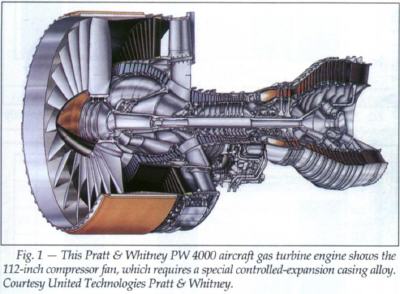
Landing Gear
Most landing gear failures have occurred as the result of stress corrosion cracking or insufficient toughness. In response to the need for improved properties, Carpenter developed AerMet® 100 alloy ,the first of two companion grades which have been used for landing gear components and other aircraft parts that are heat treated to ultrahigh strengths (Table 1). This alloy provides an exceptional combination of high strength, high hardness and fracture toughness, along with good ductility and resistance to stress corrosion cracking (Fig. 2,3). It reaches an ultimate tensile strength of 2069 MPa (285 ksi) and a minimum fracture toughness (KIC) of 110 MPa M (100 ksi in.).
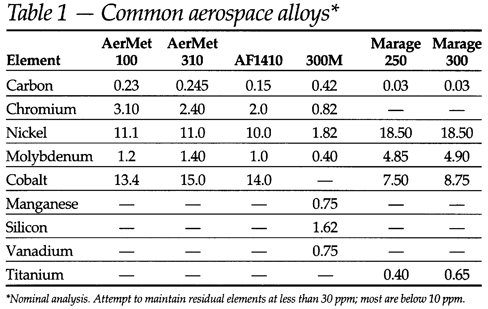
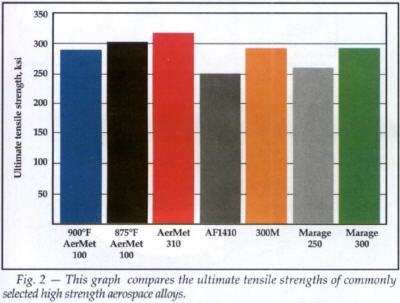
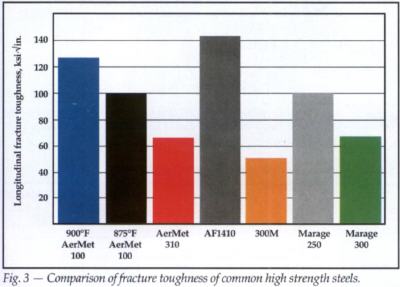
The alloy has been used for the nose and main landing gear on the U. S. Navy's F/A-18 E/F fighter jets which needed a tougher alloy with improved resistance to stress corrosion cracking for landings on carrier decks. Because of its unique combination of properties, this ultrahigh strength steel has been used also for other applications such as the shanks for arrestor hooks, fasteners and various structural parts, generally displacing 300M, AF 1410, AISI 4340 or other low alloy steels.
Compared with the commonly used 300M, AerMet 100 alloy has provided several important advantages - (a) it has three times higher fracture toughness (no lost aircraft because of landing gear fractures) (b) its critical flaw is nearly 0.25 in. (hence lower inspection costs) (c) it is slow to rust and pit (thus offering improved fatigue life in service) (d) it has significant ballistic tolerance (does not shatter or petal if punctured) (e) it exhibits no size change on heat treating if started in the mill-supplied overaged condition (meaning lower machining costs to finish) (f) it has a higher maximum use temperature (up to 400°C (750°F), with essentially no change in properties after 3000 hours exposure.
A newer version of this material known as Carpenter AerMet® 310 alloy is 10% stronger than AerMet 100 alloy without any sacrifice in ductility, as measured in a tensile test, or resistance to stress corrosion cracking. The two alloys offer the advantage of higher temperature capability than the standard alloys that have been used for landing gear.
AerMet 310 alloy combines an unprecedented high strength-to-weight ratio with excellent toughness and ductility that are exceptional at the material's high strength level. The increased strength of this alloy makes it a good candidate for next generation landing gear and other aircraft components that might benefit from high strength, smaller size and/or lighter weight. It could, for instance, allow for a smaller volume landing gear for the new large transports still in the design phase. A simple paint is a possible replacement for the chromium or cadmium banned by environmentally concerned governments.
The newer Carpenter AerMet alloy can achieve an ultimate tensile strength (UTS) of 2170 Mpa (315 ksi). It has a 2x7.5 km (1.10 mega-inch) strength-to-weight ratio (specific strength), which is higher than that of other alloys, including titanium, known for such high values.
AerMet 310 alloy has a high figure of merit for toughness, compared with other high strength alloys. This value of 4,340 measures the amount of energy that can be absorbed before the alloy fractures. Computations are based on a combination of ultimate tensile strength, yield strength, and percent elongation.
This new double-vacuum-melted alloy has 71 Mpa m (65 ksi in.) fracture toughness in the longitudinal direction. Extensive testing showed that it has a very favorable KIC/YS ratio (fracture toughness to yield strength). This characteristic should permit designers to make more damage-tolerant parts while utilizing the alloy's high strength.
Airframe
Select airframe parts and components have been made from 4130 or 4330 type alloy steels. Since these alloys rust, they must be coated or plated. The need to surface treat has been eliminated by a new alloy known as Carpenter Custom 465® stainless. This stainless steel has an unparalleled combination of high strength, fracture toughness and resistance to stress corrosion cracking.
Custom 465 stainless steel has strength similar to that of the conventional alloy steels that have been commonly used for airframe components. However, with its inherent good corrosion resistance, it has the potential for lowering the life cycle costs presently experienced with the traditional alloy steels that have been used for the same applications. Its composition is shown in Table 2.
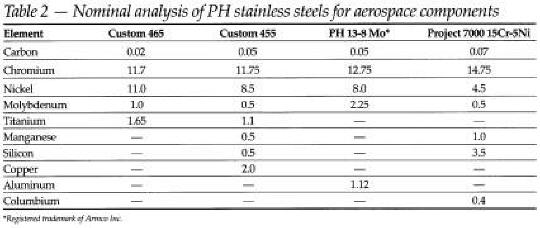
The peak-aged (H900 condition) ultimate tensile strength of Custom 465 stainless is 1790 MPa (260 ksi). In this condition, it retains higher notch tensile strength and fracture toughness than other PH grades. In the overaged H950 condition, it has a UTS of 1775 MPa (250 ksi), as shown in Fig. 4.
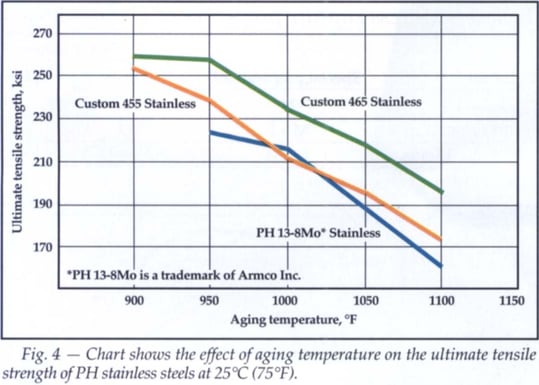
This is a premium-melted martensitic age-hardenable alloy which is less sensitive to process parameters than other high-strength PH stainless steels. Its relatively low annealed yield strength, along with a low work hardening rate make the alloy a candidate for forming fasteners and drawing small diameter wire. The steel can be cold drawn in excess of 90% reduction, with no intermediate anneal. Drawn and aged wire of this alloy can achieve a strength of more than 2070 MPa (300 ksi).
When aged to the H1000 condition, Custom 465 stainless has fracture toughness in excess of 110 MPa m (100 ksi in.), compared with about 77 MPa m (70 ksi in.) for
Custom 465 stainless has corrosion resistance comparable to that of Custom 455 stainless and PH 13-8 Mo[1] stainless, and approaching that of Type 304 stainless, but at significantly higher strength levels. When overaged to 1517-1655 MPa (220-240 ksi) ultimate tensile strength, it has stress corrosion cracking resistance similar to the other two PH stainless steels at a UTS.
Another common alloy utilized for airframe components is 15Cr-5Ni PH stainless steel. Like other grades of PH stainless steels, 15Cr-5Ni is somewhat difficult to machine. During the recent period of high demand for commercial aircraft, many machine shops were unable to produce the large number of 15Cr-5Ni parts ordered by airframe manufacturers.
Now an improved machinability version of this alloy is available. Known as Carpenter Project 7000® 15Cr-5Ni stainless, this alloy meets all the requirements of AMS 5659, and may be considered as a "drop-in" replacement for the standard grade, but with vastly improved machinability.
Beta site machining trials have yielded the following results:
-
145% improvement in productivity in a multi-operation manufacturing facility
-
a combined three times faster speed, plus three times faster feed, plus five times deeper cut in a milling operation, with no burning of cutting tools
-
tool life doubled with a modest increase in turning feed and speed (20% each)
Bar size has no effect on the improvement in machinability obtained with this double vacuum melted steel. The improved productivity, coupled with longer tool life, results in lower part cost to the OEM's.
Engines
Critical to performance of a gas turbine jet engine is the tight control of airflow in the high-pressure compressor, especially the rear section of the unit where temperatures can exceed 650°C (1200°F). Air leaking past compressor blades in either the forward or backward direction can adversely affect fuel consumption and aerodynamic stability.
The goal of the designer is to narrow the gap between the tip of the rotating compressor blades and the stationary components in the compressor's inner ring case. The challenge is to minimize clearance throughout the range of temperatures encountered in all flight conditions. Maintaining a minimal gap through all changes in temperature is essential to optimizing engine thrust, efficiency, fuel economy, flying range and parts life.
Carpenter Greek Ascoloy, a hardenable chromium-nickel-tungsten martensitic alloy and controlled expansion superalloys such as Carpenter CTX-3 and CTX-909 are used as cases for the high pressure compressor. Greek Ascoloy has a relatively high coefficient of expansion. Both controlled expansion alloys require a coating for long term resistance to oxidation at higher temperature levels.
Thermo-Span® alloy, a newer controlled expansion superalloy, offers several advantages over the mainstay alloys listed above. In addition to mechanical properties similar to those of Alloy 718, Thermo-Span alloy has a low and nearly constant coefficient of thermal expansion (COE) between room temperature and its Curie or transition temperature of 320°C (610°F) - which is the point at which its COE increases with temperature.
This Curie temperature, along with a low coefficient of thermal expansion, is desirable for compressor efficiency in normal flight mode. The alloy's higher expansivity, above the Curie temperature, works to advantage when the engine is in high thrust mode.
Thermo-Span alloy, with its improved elevated temperature oxidation resistance, can be used without coating at temperatures approaching 676°C (1250°F). Compared with traditional controlled expansion alloys, Thermo-Span alloy provides better corrosion resistance, improved thermal stability, good tensile properties and resistance to hydrogen embrittlement if processed to a fine grain size. It also has offered excellent creep resistance and microstructural stability throughout the full operating range of the engine compressors in which it was used. In summary, this newer grade offers engine manufacturers improved performance, longer component life and lower life cycle costs.
[1] PH 13-8 Mo stainless is a registered trademark of Armco Inc.
***
By James M. Dahl, Ph.D., Product Application Manager
Aerospace & Power Generation Marketing Group
Carpenter Technology Corporation
Reading, PA
USA
